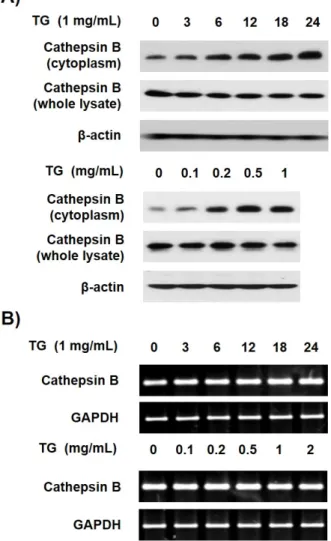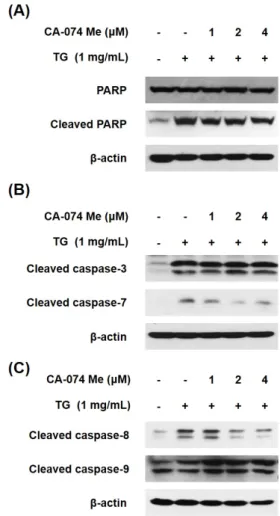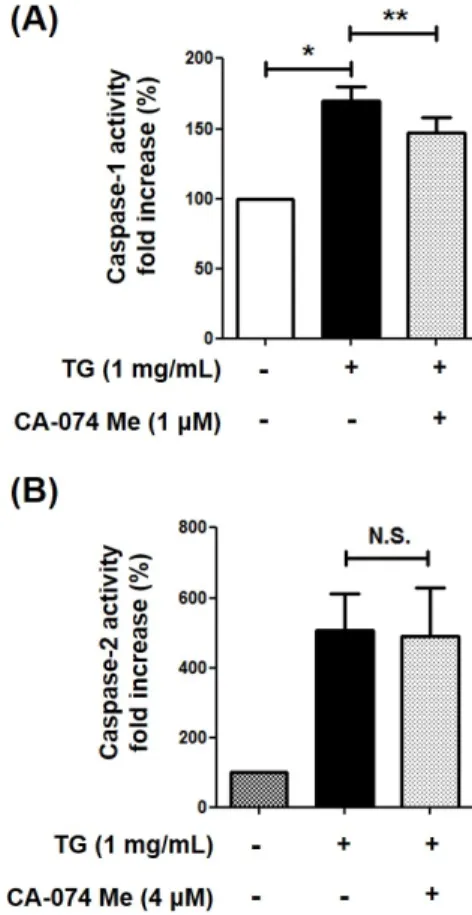Corresponding author: Yoon Suk Kim
Department of Biomedical Laboratory Science, College of Health Science, Yonsei University, 1 Yeonsedae-gil, Heungeop-myeon, Wonju 26493, Korea
E-mail: yoonsukkim@yonsei.ac.kr
ORCID: https://orcid.org/0000-0002-1956-0126
†
The first two authors contributed equally to this work.
ORIGINAL ARTICLE
Cathepsin B Is Implicated in Triglyceride (TG)-Induced Cell Death of Macrophage
Byung Chul Jung 1,2,† , Jaewon Lim 2,3,† , Sung Hoon Kim 2,4 , Yoon Suk Kim 2
1
Department of Nutritional Sciences and Toxicology, University of California, Berkeley, United States
2
Department of Biomedical Laboratory Science, College of Health Sciences, Yonsei University, Wonju, Korea
3
Department of Biomedical Laboratory Science, College of Medical Sciences, Daegu Haany University, Gyeongsan, Korea
4
Department of Biomedical Laboratory Science, Korea Nazarene University, Cheonan, Korea
중성지방에 의한 대식세포 사멸 과정에서 Cathepsin B의 영향
정병출 1,2,† , 임재원 2,3,† , 김성훈 2,4 , 김윤석 2
1
캘리포니아대학교 버클리캠퍼스 영양과학 및 독성학과,
2연세대학교 보건과학대학 임상병리학과,
3대구한의대학교 의과학대학 임상병리학과,
4
나사렛대학교 임상병리학과
ARTICLE INFO ABSTRACT
Received August 24, 2020 Revised August 27, 2020 Accepted August 28, 2020
Macrophage cell death contributes to the formation of plaque, leading to the development of atherosclerosis. The accumulation of triglyceride (TG) is also associated with the pathogenesis of atherosclerosis. A previous study reported that TG induces the cell death of macrophages. This study examined whether the cytoplasmic release of cathepsin B from lysosome is associated with the TG-induced cell death of macrophage. The release of cathepsin B was increased in the TG-treated THP-1 macrophages, but the TG treatment did not affect cathepsin B expression. Furthermore, the inhibition of cathepsin B by its inhibitor, CA-074 Me, partially inhibited the TG-induced cell death of macrophage. TG-triggered macrophage cell death is mediated by the activation of caspase-1, -2, and apoptotic caspases. Therefore, this study investigated whether cathepsin B is implicated in the activation of these caspases. The inhibition of cathepsin B blocked the activation of caspase-7, -8, and -1 but did not affect the activity of caspase-3, -9, and -2. Overall, these results suggest that TG-induced cytoplasmic cathepsin B causes THP-1 macrophage cell death by activating caspase-1, leading to subsequent activation of the extrinsic apoptotic pathway.
Copyright Ⓒ 2020 The Korean Society for Clinical Laboratory Science. All rights reserved.
Key words Caspase-1 Cathepsin B Cell death THP-1 macrophage Triglyceride
INTRODUCTION
Atherosclerosis is a prevalent disease caused by clogged arteries with lipid-rich plaque, which, in turn, progress myocardial ischemia [1]. The prevalence of clinical atherosclerosis per 1,000 individuals was 101.11 in 2015 in South Korea [2]. While a variety of cell
types contribute to the pathogenesis of atherosclerosis, macrophages play a pivotal role in terms of plaque formation and development [3]. In the initial stage of atherosclerosis, macrophages engulf cholesterol-rich lipoprotein via specific receptors and subsequently are converted to foam cells, which is a crucial step for the development of plaque formation [4]. As plaques develop, macrophage cell death increases, which contributes to the development of vulnerable plaques [5]. Previously, our group have reported that TG induces cell death of macrophages implying the implication of TG in the
Korean Society for Clinical Laboratory Science


